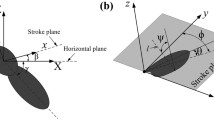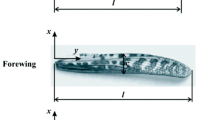Summary
Stationary flight of siskins (Carduelis spinus) was achieved by tethering them in a harness of yarn strands fastened to a metal rod (Fig. 1). The wing-beat frequency and the wing-stroke angles were recorded by miniature movement detectors, i.e. small sensing coils glued on the armwings. Kinematic parameters were also recorded cinematographically. The aerodynamic parameters, lift and thrust, of the tethered flying birds could be measured by mechanoelectric transducers in a flight balance (Fig. 2). The frontal air current of a wind tunnel (Fig. 3) stimulated the flight movements, and generated a drag which opposed the thrust. When these two forces were brought into equilibrium, the wind speed equaled the flight speed of the bird in relation to the air.
Tethered flight begins with a continuous flight which changes to the leaping flight in which flapping intervals alternate with pauses (Fig. 4). The leaping flight lasts up to two hours. The wing-beat frequency is about 19 Hz both, during the continuous flight and the flapping intervals of the leaping flight. However, it is only about 9 Hz during the leaping flight if the pauses are averaged in, too. The flight pattern as well as the kinematic of the wing movements (Fig. 5) of tethered flying siskins resembles those of free flying small birds. Whereas just after the start the generated lift is greater than the body weight of the siskin, these two forces are approximately in equilibrium during the following flight periods (Fig. 6). If, in addition, the thrust of the flying siskin compensates its drag, the aerodynamic situation of this tethered flight equals that of horizontal, nonaccelerated free flapping flight.
Similar content being viewed by others
References
Biederman-Thorson, M., Thorson, J.: Rotation-compensating reflexes independent of the labyrinth and the eye. J. comp. Physiol.83, 103–122 (1973)
Bilo, D.: Untersuchungen über die Flugbiophysik von Kleinvögeln (unter Anwendung der Hochfrequenz-Stereokinematographie und der Windkanaltechnik). Inaug.-Diss., München 1969
Bilo, D.: Flugbiophysik von Kleinvögeln. I. Kinematik und Aerodynamik des Flügelabschlages beim Haussperling (Passer domesticus L.). Z. vergl. Physiol.71, 382–454 (1971)
Bilo, D.: Flugbiophysik von Kleinvögeln. II. Kinematik und Aerodynamik des Flügelaufschlages beim Haussperling (Passer domesticus L.). Z. vergl. Physiol.76, 426–437 (1972)
Csicsáky, M.J.: Body-gliding in the zebra finch. Fortschr. Zool.24, 275–286 (1977)
Gewecke, M.: The influence of the air-current sense organs on the flight behaviour ofLocusta migratoria. J. comp. Physiol.103, 79–95 (1975)
Gewecke, M., Woike, M.: Breast feathers as an air-current sense organ for the control of flight behaviour in a songbird (Carduelis spinus). Z. Tierpsychol.47, 293–298 (1978)
Hagiwara, S., Chichibu, S., Simpson, N.: Neuromuscular mechanisms of wing beat in hummingbirds. Z. vergl. Physiol.60, 209–218 (1968)
Koch, U.T.: A miniature movement detector applied to recording of wingbeat inLocusta. Fortschr. Zool.24, 327–332 (1977)
Marey, E.-J.: Le vol des oiseaux. Paris: Massen 1890
Nachtigall, W.: Die Kinematik der Schlagflügelbewegungen von Dipteren. Methodische und analytische Grundlagen zur Biophysik des Insektenflugs. Z. vergl. Physiol.52, 155–211 (1966)
Nachtigall, W.: Biophysik des Tierflugs. Rhein.-Westf. Akad. Wiss. N236, 73–152 (1974)
Norberg, U.M.: Hovering flight in the pied flycatcher (Ficedula hypoleuca). In: Swimming and flying in nature, Vol. II (ed. T.Y.-T. Wu, C.J. Brokaw, C. Brennen), pp. 869–881. New York: Plenum Publishing Corporation 1975
Oehme, H.: Der Rüttelflug des Gartenrotschwanzes (Phoenicurus phoenicurus). Beitr. Vogelkd.15, 417–433 (1970)
Pennycuick, C.J.: Power requirements for horizontal flight in the pigeonColumba livia. J. exp. Biol.49, 527–555 (1968)
Rüppell, G.: Flugmanöver des Gartenrotschwanzes (Phoenicurus phoenicurus L.). Z. vergl. Physiol.71, 190–200 (1971)
Stolpe, M., Zimmer, K.: Der Schwirrflug des Kolibri im Zeitlupenfilm. J. Orn.87, 136–155 (1939)
Tucker, V.A.: Respiratory exchange and evaporative water loss in the flying budgerigar. J. exp. Biol.48, 67–87 (1968)
Woike, M.: Verhaltensphysiologische Untersuchungen an fixiert fliegenden Zeisigen (Carduelis spinus L., Aves, Passeres). Diplomarbeit, Düsseldorf 1976
Author information
Authors and Affiliations
Additional information
We wish to thank Prof. Dr. D. Bilo for helpful discussions concerning the construction of the wind tunnel, and Drs. U. Koch and W. Zarnack for kindly showing us how to work with the miniature movement detectors. Thanks are also due to the Beringungsgemeinschaft Schönholz for catching the siskins. We are grateful to Dr. J. Dean for reading the manuscript, and Mr. E. Friedrich for preparing the figures. This work was supported by grants from the Deutsche Forschungsgemeinschaft (Ge 249/2, 4 and 5).
Rights and permissions
About this article
Cite this article
Woike, M., Gewecke, M. Kinematic and aerodynamic parameters in tethered flying siskins (Carduelis spinus, Passeres, Aves). J. Comp. Physiol. 127, 123–129 (1978). https://doi.org/10.1007/BF01352296
Accepted:
Issue Date:
DOI: https://doi.org/10.1007/BF01352296




